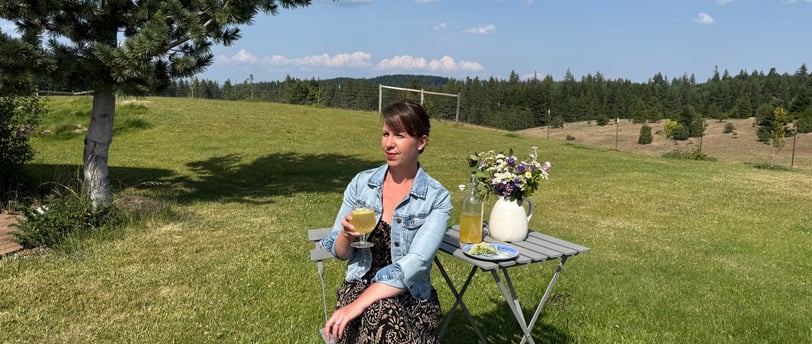How to Make Naturally Fizzy Elderflower Champagne (Non-Alcoholic)
Learn how to make naturally fermented, non-alcoholic elderflower champagne with simple ingredients and no special equipment. Discover the benefits of elderflowers and how this seasonal drink ties into faith-based, holistic living.
HEALTHY RECIPES
6/27/20253 min read


Every year I wait in anticipation for the elderflowers to bloom. They always come and go quicker than I expect. Just like my favorite flowers—peonies. I think this is such a great reminder of how we should enjoy the blessings we have in the moment, because life is so fleeting.
This year, I decided to make a non-alcoholic elderflower champagne. I’ve made elderflower liqueur before, but thought it would be fun to try something bubbly that my niece and nephew could enjoy too!
Elderflowers have so many benefits...
I’ve heard it said that simply being near blooming elderflowers, with their sweet, delicate fragrance and calming energy, brings a sense of peace and lightness. A little tip: harvest them early in the morning to avoid bugs. You don’t want to wash away the flavorful pollen—just give them a good shake.
This gentle connection to nature aligns beautifully with the trending wellness practice of forest bathing—the simple act of spending time among trees. It’s scientifically proven to reduce stress, boost mood, and support immune health.
Even though I’m not really a “woo-woo” person, I do believe God gave us more healing power in His creation than we’ve even begun to fully understand.
Medicinal Benefits of Elderflowers:
Anti-viral and immune boosting
Soothing for colds and respiratory infections
Anti-inflammatory and supportive for allergies
Natural diuretic and mild detoxifier
While elderberries are more famous for immune support, the blooms have similar medicinal properties and are wonderful as fresh tea, champagne, homemade liquor or dried for winter use.
🍋 Tip: Elderflowers can also be dried and brewed like black tea — the flavor changes to an almost black-tea like beverages when dried... Perfect for winter!
My favorite part about seasonal recipes like this is how much they invite us to slow down and be present. This elderflower drink is a simple way to connect with the season, with your health, and with the joy that comes from living in alignment with God’s design. Using His creation as medicine is not only nourishing—it bring a joy you can find nowhere else and is truly delicious!
If you'd like to know how to make elderberry syrup (anytime of the year with dried elderberries), I have a FREE elderberry syrup guide you can download to get started with your own herbal medicine cabinet at home. Download HERE.
“And the leaves of the tree were for the healing of the nations.” — Revelation 22:2
Elderflower Champagne Recipe (Non-Alcoholic)
This naturally fizzy elderflower champagne is a gentle, refreshing drink made with fresh elderflowers, lemon, and just a little sweetness. It’s non-alcoholic and fermented the old-fashioned way—using the natural yeasts God placed in creation. Perfect for sipping on the porch, sharing with family, or just pausing to enjoy the beauty that’s all around us.
SEE IT ON YOUTUBE
Ingredients:
3 to 4 cups loosely packed elderflower heads (about 10–15 fresh flower clusters)
1 gallon filtered water (make sure it's not chlorinated)
¾ to 1 lb organic cane sugar (or a mix of honey and sugar if preferred)
2 organic lemons, sliced
1 tablespoon organic raw apple cider vinegar (optional, helps jumpstart fermentation)
Instructions:
1. Prepare the Elderflowers
Harvest them early in the day. Shake gently to remove bugs but don’t wash. Trim away any thick stems.
2. Make the Base
In a large bowl or food-safe container, dissolve the sugar in a bit of hot water (not too hot if you are using honey as to not kill the beneficial properties). Add enough cold filtered water to make up one gallon. Stir in the lemon slices, and apple cider vinegar.
3. Add the Elderflowers
Add the elderflower heads and stir well. Cover loosely with a clean cloth or towel and set in a warm spot out of direct sunlight. Let steep for 2 to 3 days, stirring once or twice a day.
4. Look for Bubbles
You’ll notice tiny bubbles forming on the surface. This is a good sign. If you see small white dots that aren’t fuzzy or colored, it’s most likely just natural yeast—harmless and expected in wild fermentation. Mold will look fuzzy or web-like and have an unpleasant odor. If you're unsure, skim the top or reach out with a photo (alicia@theblossomingtable.com).
5. Strain and Bottle
Strain the mixture through a fine mesh strainer or cheesecloth into sterilized bottles. Leave a couple inches (I left a lot more to be on the safe side) at the top. Swing-top glass bottles work well, but recycled plastic soda bottles are safer for monitoring pressure.
6. Optional Second Fermentation
Leave bottled champagne at room temperature for 1–3 days to build up fizz. If using plastic bottles, you’ll know they’re ready when they feel firm to the squeeze. Once bubbly, place bottles in the fridge to chill.
7. Serve and Enjoy
Chill well and serve in a glass with a twist of lemon and elderflower blossoms. Drink within 2–3 weeks, stored in the refrigerator.
Tips and Troubleshooting
Don’t go too low on sugar or it may not ferment.
If your home is cool, fermentation may take a little longer.
Check bottles daily to avoid pressure buildup. “Burp” them if needed.
Subscribe to my newsletter
Organic recipes, non-toxic healthy living tips & be a part of a community designed to fuel your journey to health and wellness by using God's Creation as Medicine.


